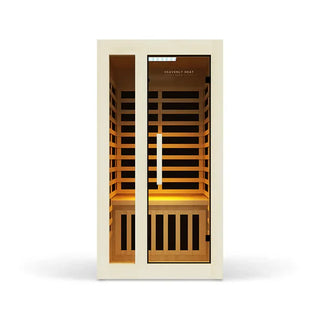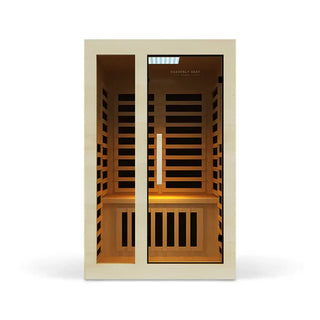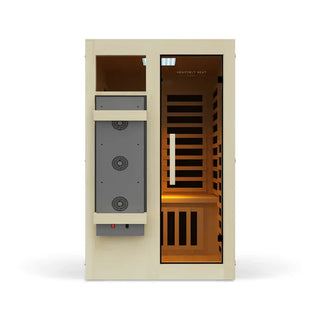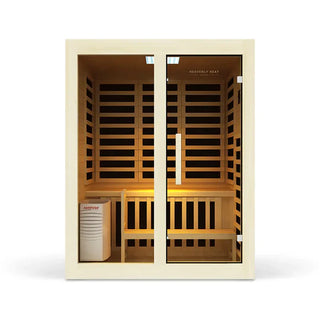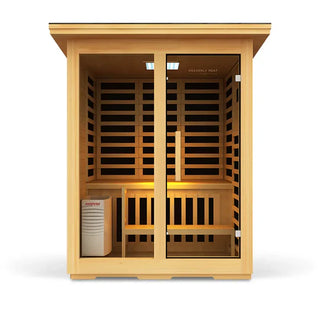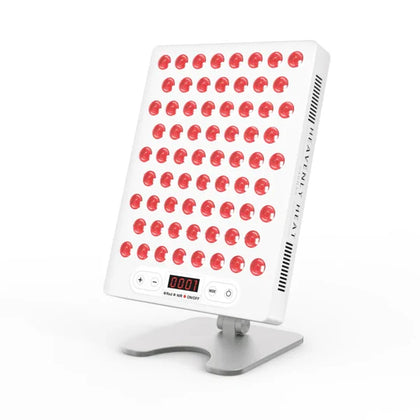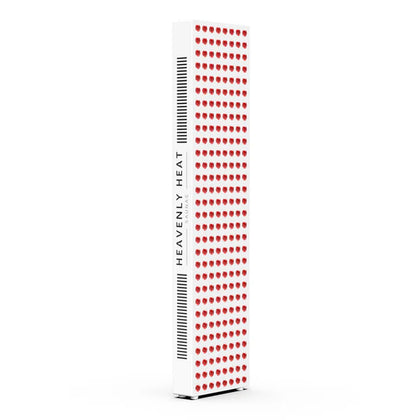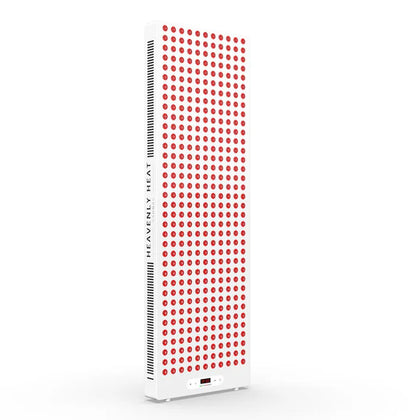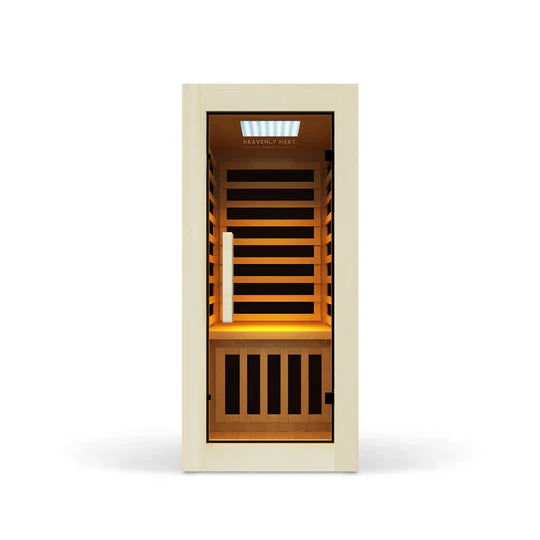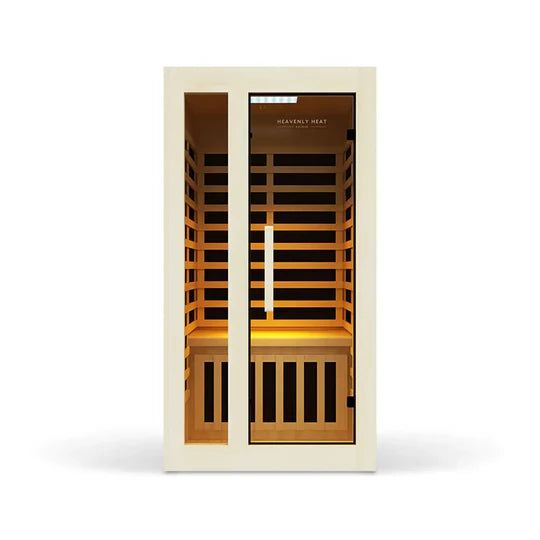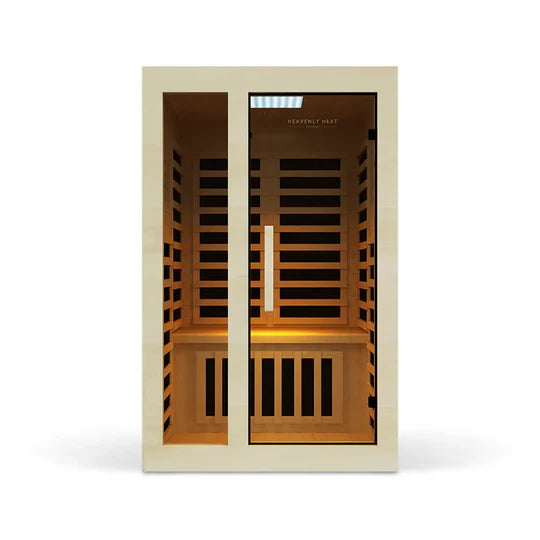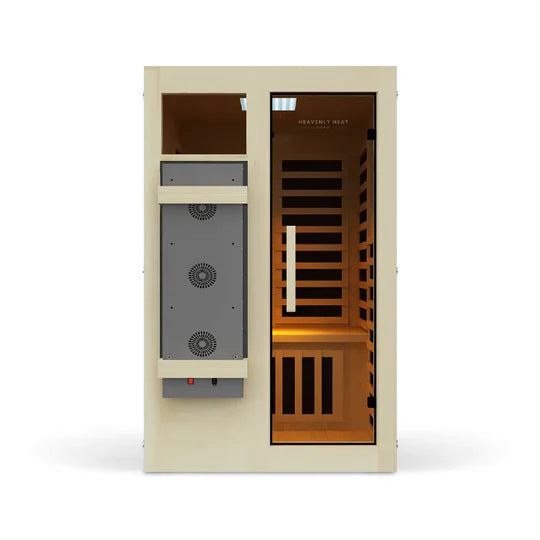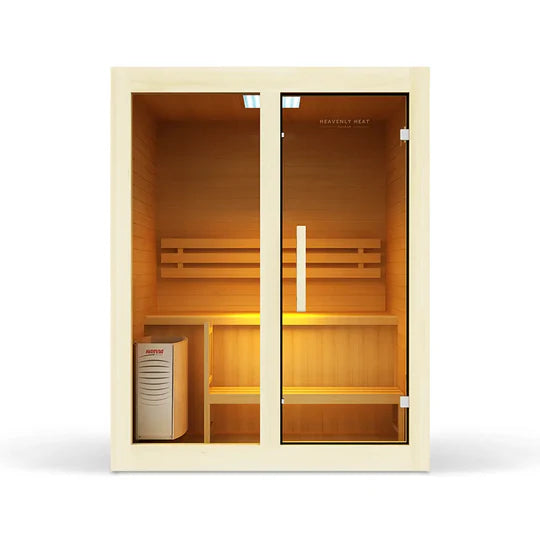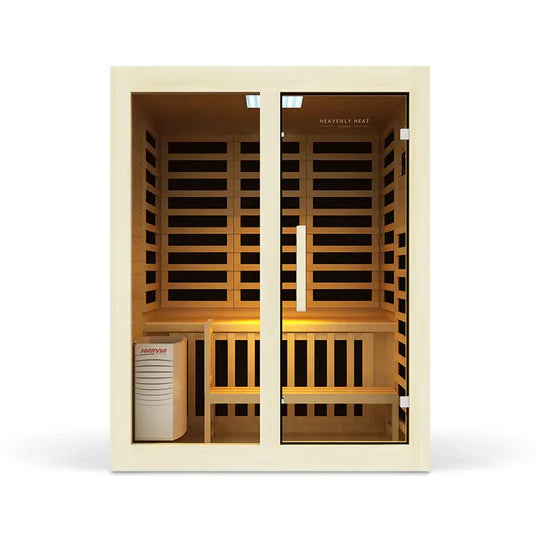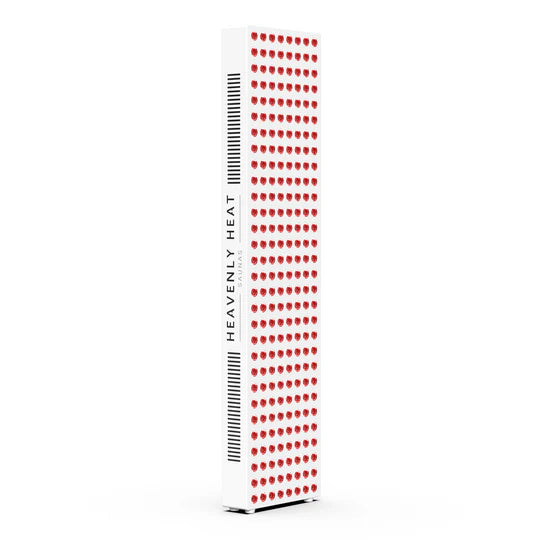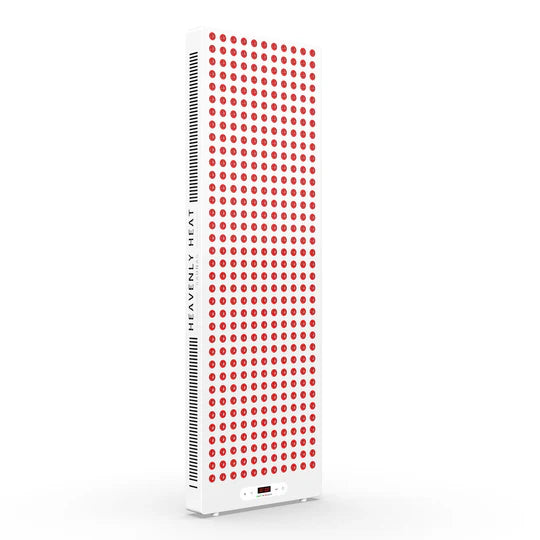How Hot are Saunas and What Temperature Should a Sauna Be?
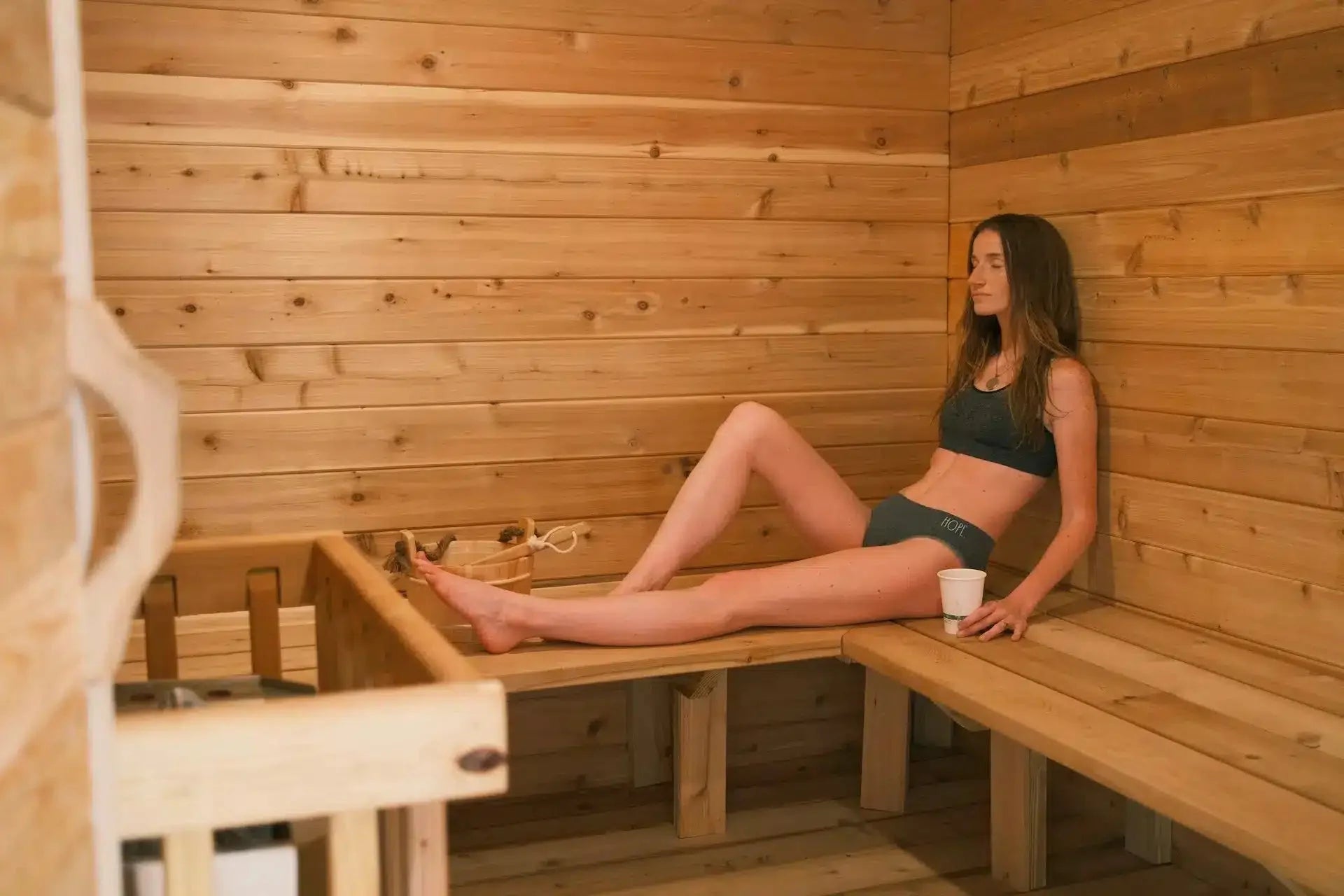
For centuries, people have used heat therapy to help them relax, undergo detoxification, relieve muscle pain, and improve sleep.
If you’re a new sauna owner or going for the first time in a public sauna, you may not know what temperature your sauna should be.
In this article, we will explore the different sauna temperatures and discuss the ideal temperature range for a sauna.
Table of contents
Key Takeaways
-
Choosing the right sauna temperature is crucial to maximizing benefits while avoiding overheating and dehydration.
-
Infrared saunas operate at lower temperatures (120-140°F), while traditional saunas can reach up to 200°F.
-
Steam saunas provide high humidity with temperatures ranging from 100-120°F, offering respiratory benefits.
-
Safe sauna use depends on age, health conditions, and individual tolerance, with lower temperatures recommended for children, pregnant women, and older adults.
-
Staying hydrated, cooling down after a session, and adjusting the temperature to personal comfort are keys to a safe and enjoyable sauna experience.
Why is sauna temperature important?
Temperature Controls the Benefits: To fully enjoy the benefits of a sauna, choosing the right temperature is crucial. You cannot maximize the benefits if the temperature is too low, and if it’s very high, it can lead to overheating,
Typical Sauna Temperature Ranges: Traditional Finnish saunas typically range from 150°F to 195°F (65°C to 90°C), encouraging deep sweating and detoxification. In contrast, infrared saunas operate at lower temperatures, between 120°F and 150°F (49°C to 65°C), offering a gentler, deeper heat that helps with muscle relaxation and recovery.
Historical Roots of Sauna Use: If the sauna temperature is too high, it can cause dehydration, overheating, or even heatstroke.
Expert Insights on Sauna Health Benefits: Dr. Victoria Maizes, an expert in integrative medicine, highlights that saunas can reduce stress, detoxify the body, and improve heart health.
How Heat Therapy Affects the Body: She notes that heat therapy boosts circulation, promotes relaxation, and benefits skin health. As the sauna temperature rises, your skin temperature can reach about 40°C (104°F), which causes heavy sweating and increases heart rate as the body works to stay cool.
Finding the Right Balance: To experience these benefits fully, it’s important to choose the right temperature for your sauna session. The right temperature helps ensure that your body can relax and heal without the risk of overheating or dehydration.
Key Takeaways:
Ideal sauna temperature is crucial for safety and effectiveness
Traditional Finnish saunas: 150°F–195°F (65°C–90°C)
Infrared saunas: 120°F–150°F (49°C–65°C)
Too high = risk of overheating, dehydration, or heatstroke
Proper temperature boosts circulation, relaxation, detox, and skin health
Choose a temperature that’s comfortable and safe for your body
How hot should a sauna be for effective detoxing?
For effective detoxing, saunas should be hot enough to make you sweat but still feel comfortable. Infrared saunas are gentler, while traditional ones are hotter for a deeper cleanse.
For optimal benefits, aim for sessions of 15-30 minutes, depending on your heat tolerance and sauna type. Drink plenty of water, and don’t stay in too long to avoid feeling dizzy.

How hot can a sauna get?
Infrared sauna
Temperature Range: Infrared saunas typically operate at a lower temperature range of 120˚F and 140˚F.
How Infrared Heat Works: These saunas use infrared heaters to emit radiant heat that is absorbed by the skin, providing a gentle and comfortable experience for users.
Ideal for Heat-Sensitive Users: The lower temperature makes infrared saunas ideal for individuals who can’t tolerate the high heat of traditional saunas.
Therapeutic Support: Evidence suggests infrared saunas can be used alongside other treatments for various health issues, offering relief for those with sensitive skin or breathing problems .
Muscle Recovery & Circulation: Infrared saunas help reduce lactic acid buildup and improve circulation , supporting faster post-workout recovery .
Dry/Traditional Sauna
Temperature Range: Dry or traditional saunas can reach temperatures as high as 200°F (85°C) .
Heating Method: These saunas use a stove or electric heater to warm rocks , which then radiate heat into the room.
Wood-Burning Experience: Wood-burning heaters create a rustic atmosphere and require manual temperature control .
Intense Heat & Detox: The high heat promotes intense sweating , which helps with relaxation and detoxification .
Humidity Boost with Water: Pouring water on hot stones increases humidity and makes the sauna feel hotter— only effective when the stones are fully heated .
Safety for Beginners: Beginners should start with 5–10 minute sessions and gradually increase to 15–20 minutes , while staying hydrated and mindful of overheating .

Steam sauna
Steam saunas, also known as steam rooms, generally maintain a temperature range of 100°F to 120°F (38°C to 49°C).
These saunas produce steam by pouring water over heated rocks or using a steam generator.
The humidity levels in steam saunas are higher compared to other types of saunas, creating a moist environment that can help open up the pores and improve circulation.
The moist heat in steam rooms also hydrates the skin, promoting detoxification and improving skin health, making it more effective than dry heat for skin hydration.
Many people with asthma find warm air soothing, and steam can help clear mucus that makes it hard to breathe. However, it’s important to note that heat can worsen asthma for some, so it’s crucial to understand personal triggers.
Steam saunas are often favored for their respiratory benefits, as the steam can help alleviate congestion and promote easier breathing.
Sentō (Japanese public baths) are traditional Japanese public baths that focus on soaking in hot water, offering relaxation and therapeutic benefits,
(Japanese public baths) and onsen are alternatives to saunas, using mineral-rich hot water instead of dry heat.
Onsen uses warm mineral-rich water to relax muscles, improve circulation, and aid recovery.
These are presented as distinct alternatives, focusing more on therapeutic soaking than on heat exposure.
Maximum Temperature Limits of Different Saunas
Saunas can get extremely hot, but the exact temperature depends on the type. The hottest saunas, like Finnish saunas, can reach 195°F (90°C), though most people prefer temperatures between 150–175°F (65–80°C).
Russian banyas, known for their high heat and humidity, can go up to 200°F (93°C).
Banya, a traditional Russian steam room with 40–60% humidity, differs from dry Finnish saunas.
Russian banyas often incorporate venik (a leafy bundle used to massage the body and spread steam), a traditional practice believed to improve circulation and enhance detoxification.
Banya attendants in Russian baths may provide whisk massages to enhance detoxification.
Steam saunas, or steam rooms, feel hotter due to humidity but usually stay around 110–120°F (43–49°C).
Electric saunas, common in homes, are usually capped at 194°F (90°C) for safety.
Public saunas often follow strict regulations, keeping their maximum temperature within safe limits, usually around 180–190°F (82–88°C) to ensure comfort and safety.

Why Saunas Feel Hotter at the Same Temperature
A sauna feels much hotter than a regular room at the same temperature because of the way heat interacts with the body.
Unlike a normal room, where heat spreads out, a sauna traps it, making the air feel dense and intense.
Humidity plays a big role, too—dry saunas feel easier to handle, while adding water to sauna rocks creates steam, making the air thicker and heat more overwhelming.
Infrared saunas feel different because they heat the body directly instead of the air. Air circulation also matters—less movement keeps heat concentrated.
Whether dry or humid, your body works harder to stay cool, making the heat feel stronger.

Summary
Saunas can get extremely hot, with different types offering varying temperature ranges. Infrared saunas are gentler, while traditional dry and steam saunas can reach intense heat. Knowing your limits and staying hydrated is key for a safe and enjoyable sauna experience.
Determining the Ideal Temperature Range for Sauna
Finding the ideal temperature for the sauna means figuring out the best balance between getting the benefits of exposing your body to heat and making sure it’s not too extremely hot for your body to handle.
It’s like finding the sweet spot where you get the advantages without it being too uncomfortable or risky for you.
While individual preferences may vary, many people prefer a temperature range between 150-175 degrees Fahrenheit for traditional saunas and 120-130 degrees Fahrenheit for infrared saunas.
Begin with lower sauna temperatures, around 120-140°F for beginners or infrared sauna users, and gradually increase by 5-10°F at a time to find your comfort zone.
Dr. Rhonda Patrick, a well-known expert in health optimization, typically uses a sauna temperature of around 174°F (about 80°C) with humidity levels between 10-20%. She adjusts the temperature based on her workout and comfort level, ensuring an optimal sauna experience tailored to her needs.
However, this high temperature is not recommended for beginners, as it may be too intense to tolerate, especially if you are not accustomed to the heat.
It’s important to listen to your body and avoid pushing yourself if you can’t tolerate a high temperature.
If the heat feels overwhelming, reduce the temperature or shorten your sauna session.
Your body will signal when it’s time to exit or cool down, and it’s crucial to respect those signals to avoid discomfort or health risks.
Sauna temperatures in this range are hot enough to relax your body but not excessively hot to make you uncomfortable or pose any risk of overheating or dehydration.
Keep in mind that the sauna temperature settings may vary depending on factors such as individual tolerance to heat, health conditions, age, and the purpose of the heat therapy.
Additionally, it’s a good practice to take a cool shower or rest in a cool room after your sauna session to help regulate your body temperature and promote relaxation.
Quick Summary:
Traditional Sauna: 150–175°F (65–80°C)
Infrared Sauna: 120–130°F (49–54°C)
Beginners: Start at 120–140°F and increase gradually
Expert Tip: Dr. Rhonda Patrick uses 174°F with 10–20% humidity
Listen to Your Body: Exit or cool down if it feels too hot
Aftercare: Cool shower or rest helps regulate temperature
Safe Sauna Temperature
It is important to stay safe while relaxing in the sauna. The Finnish Sauna Society advises never to exceed 212 degrees Fahrenheit (100 degrees Celsius) in your sauna, as a temperature of 100 degrees Celsius or higher can potentially lead to heat exhaustion, dehydration, and other heat-related illnesses.
Remember that your age and health are important factors in setting the temperature. Here are a few factors to consider:
For kids
If kids will be using the sauna, the recommended temperature is around 105 to 130 degrees Fahrenheit or lower to ensure they don’t overheat.
Kids can't handle heat as well as adults. In fact, severe heat can lead to muscle breakdown, kidney failure, seizures, coma, or even death in the worst cases, according to a working paper from the Center on the Developing Child at Harvard.
That’s why it’s essential to keep sauna sessions short and monitor their well-being closely.
Children aged 6 and above should be supervised and should stay no longer than 15 minutes in the sauna at a time. Always stay nearby and make sure they’re feeling okay.
For Those with Health Conditions
People with health issues, especially heart disease, should consult their doctor before using a sauna.
Your doctor may advise against sauna use if you have heart disease or may suggest keeping the temperature low and limiting the session's duration.
Limit your sauna time to no more than 20 minutes, allow time to cool off afterward, and stay hydrated.
Avoid cold water immersion if you have heart disease, as it can trigger heart instability.
Be sure to drink water and eat a light snack before entering, rehydrate afterward, and exit immediately if you experience dizziness, chest pain, or a rapid heartbeat.
When pregnant
If you're pregnant, staying safe in the sauna means knowing the risks and being cautious.
High temperatures can cause dehydration, overheating, and even dizziness, which may affect both you and your baby.
Pay close attention to how you feel. If you start feeling lightheaded, nauseous, or overly hot, leave the sauna immediately.
The first trimester can be especially risky because the baby is still developing, so avoiding saunas during this time might be the safest choice.
It’s generally recommended to stop using the sauna around 4 to 6 weeks before your due date, especially during the third trimester, to ensure both your health and your baby’s.
Always keep sauna sessions short, no longer than 10 minutes, and never let the temperature go over 104°F (40°C). For your health and peace of mind, talk to your doctor before stepping into a sauna.
Recognizing When the Heat is Too Much
When a sauna gets too hot for your body, your body will send clear signals. Feeling dizzy or lightheaded is a major red flag—this happens when the heat causes your blood pressure to drop.
Nausea is another warning sign that your body is struggling with the temperature. If you start feeling faint, leave the sauna immediately, cool off, and drink plenty of water to rehydrate.
If you start feeling faint, leave the sauna immediately and cool down. Heat exhaustion can also cause extreme sweating, weakness, or confusion.
Dehydration makes everything worse, reducing your body's ability to handle the heat.
To stay safe, drink water before and after your session and listen to your body—when it feels too much, step out.
Adjusting Sessions Based on Personal Tolerance
Finding your ideal sauna temperature starts with listening to your body. Begin with shorter sessions at a moderate heat, around 150°F (65°C), and pay attention to signs like dizziness, nausea, or extreme sweating—these mean it’s time to step out.
Increase the temperature gradually as your body adjusts, and avoid pushing your limits to ensure a comfortable experience.
Everyone’s heat sensitivity is different, so adjust the temperature or session length to match your comfort level.
Staying hydrated is key; drink water before and after to help your body handle the heat. Over time, you can build tolerance by gradually increasing duration and temperature. If you want to push your limits, do it slowly and safely to avoid overheating.
| Group | Recommended Temperature | Notes |
| Children | 105-130°F | Keep sessions short, supervise closely |
| Pregnant Women | ≤104°F (40°C) | Avoid overheating, consult a doctor |
| Adults | 150-175°F (traditional) / 120-130°F (infrared) | Adjust based on comfort and tolerance |
| Elderly | 110-140°F | Stay hydrated, limit duration |
| People with Health Conditions | Lower temperatures (as advised by a doctor) | Always consult a healthcare professional |
Summary
Always listen to your body in the sauna. Keep temperatures safe, sessions short, and stay hydrated. Adjust based on your health, age, or pregnancy. If you feel dizzy or unwell, leave immediately. Your comfort and safety matter most for a good experience.
How can you measure the temperature in a sauna accurately?
To measure sauna temperature accurately, use a thermometer designed for sauna use.
These thermometers can handle high heat and humidity, providing reliable results.
Analog thermometers are a popular choice because they are simple and durable, while digital ones offer precise readings.
Smartphone apps might seem helpful, but they are not accurate for sauna conditions due to heat sensitivity and poor calibration.
For the most accurate reading, place the thermometer at the level of the sitting platform, away from the wall, as air temperature can vary significantly at different heights.
Quick Summary:
Use a sauna-specific thermometer (handles heat & humidity)
Analog = durable & simple; Digital = more precise
Avoid smartphone apps (not accurate in saunas)
Place thermometer at sitting level, away from walls
Tips to make your sauna experience better
To enhance your sauna experience, here are some tips to keep in mind.
Stay Hydrated
The heat in a sauna makes you sweat a lot, which means your body loses fluids quickly.
To stay hydrated and feel your best, drink at least two to three glasses of water before and after your session.
For every 10 minutes you spend in the sauna, drink at least 16 ounces of water to replace what you lose through sweating.
If plain water feels boring, go for herbal teas or electrolyte-rich drinks like coconut water or electrolyte-infused waters Electrolytes are charged substances that help maintain fluid balance and support hydration during sweating, electrolyte drinks as they work great to restore what you lose through sweating.
But be careful with what you drink. Avoid alcohol or caffeine before and after your sauna time since they can dehydrate you even more.
Watch out for signs like dry mouth, dizziness, or a headache. These are clues your body needs more fluids.
Keep your hydration game strong, and you will enjoy your sauna experience to the fullest!
Consider the preferences of everyone in the sauna
When relaxing with friends or family members in the sauna, consider their preferences and set a temperature that’s appropriate for everyone in the group.
Sauna etiquette includes sitting on a towel, avoiding loud behavior, and never stretching out if the sauna is crowded.
This ensures a respectful and comfortable experience for everyone sharing the space.
Cool down after hitting the sauna
When you step out of the sauna, don’t rush straight into the shower. Give yourself a couple of minutes to let your body adjust to the cooler air.
According to the classic Finnish method, it's common to wait at least two minutes before jumping into a cold or lukewarm shower.
Once you feel ready, hop into a refreshing shower with cool or lukewarm water. Cooling down the right way helps bring your heart rate back to normal, refreshes your skin, and prevents dizziness.
In traditional Finnish sauna rituals, people often enjoy multiple short sessions with cooling breaks in between, like jumping into cold water or even rolling in the snow.
It’s also a great way to close your pores and leave your body feeling clean and energized after all that heat.
Wearing Appropriate Attire for a Comfortable Sauna Experience
Wearing the right clothes in a sauna is important for your comfort. If you wear tight or non-breathable clothing, it can trap heat, making you feel uncomfortable or even cause skin irritation.
Natural fabrics like cotton and linen are great because they’re breathable, lightweight, and absorbent, helping your sweat evaporate instead of trapping heat.
Without the right attire, you could overheat or become dehydrated, which would ruin your sauna experience.
Setting a Timer for Optimal Sauna Sessions
A sauna timer is a specialized timer designed to handle the high heat and humidity of a sauna.
It’s built to be durable and easy to use, so you can safely track your session. Beginners may want to start with just 5 to 10 minutes and gradually build up, but don’t go beyond 20 to 30 minutes at a time.
Using a sauna timer prevents you from overstaying, keeping your experience comfortable and ensuring you don’t risk dizziness or exhaustion.
Pre-Sauna Routines for Relaxation and Comfort
Before stepping into a sauna, it’s important to prepare your body and mind for the heat.
Start with a quick shower to cleanse your skin, rinse off sweat and oils , and open your pores.
This not only improves hygiene but also helps your skin absorb the heat more effectively, making your sauna experience more enjoyable.
Staying hydrated is key, so drink plenty of water beforehand to avoid dehydration. A few light yoga stretches can loosen your muscles, warm them up, enhance flexibility, and help you feel mentally ready for the relaxation ahead.
A few light yoga stretches can loosen your muscles, making relaxation easier. Meditation helps clear your mind, allowing you to fully enjoy the sauna’s calming effects.
To unwind mentally, focus on deep breathing and let go of stress. When you take these simple steps, your sauna session becomes more refreshing, leaving you feeling completely relaxed and rejuvenated.
Post-Sauna Practices to Maximize Benefits
After a sauna, your body needs proper care to maximize the benefits. Start with hydration—drink at least 500ml to 1 liter of water to replace lost fluids and avoid dizziness.
Follow up with a cold shower or ice bath to improve circulation and muscle recovery. Your skin also needs attention—gently cleanse, exfoliate, and apply a hypoallergenic moisturizer that suits your skin type to lock in moisture and keep it soft . moisturize to exfoliate, and moisturize to protect dehydrated skin , keep it healthy.
You can also enhance circulation with a Vihta, a traditional Finnish sauna whisk made of birch or oak branches.
The Vihta is used to gently beat the skin, which stimulates circulation, promotes detoxification, and improves skin health.
Gently beating the skin with the Vihta helps stimulate circulation, further supporting detoxification and skin health.
If you’re wondering about exercise, light stretching is fine, but intense workouts can strain your body.
A sauna also improves sleep, so relax and avoid screens before bed. Lastly, don’t make mistakes like skipping hydration or rushing back into daily activities!
Summary
To get the most out of your sauna experience, stay hydrated, wear breathable clothing, and respect others’ preferences. Start with a pre-sauna routine, keep your sessions moderate, and cool down properly. Afterward, hydrate, cleanse, and moisturize your skin to maximize benefits and relaxation.
What are the health risks related to extreme sauna temperatures?
Dr. Victoria Maizes, an expert in integrative medicine, emphasizes that while saunas provide numerous benefits, extreme temperatures can pose significant risks.
Dehydration and heat-related complications are significant concerns, with risks including heat exhaustion, fainting, and heat stroke, says Wan Na Chun, Some of the health risks associated with spending time in a sauna at extremely high temperatures, especially for individuals with pre-existing health conditions, include:
- Heat stroke
- Dehydration
- Skin burn
- Heat exhaustion
However, even as a healthy adult, you should be vigilant about the sauna temperature to avoid these health risks
It’s important to listen to your body and adjust the temperature depending on your tolerance and comfort levels.
Summary
Risk of heat stroke and heat exhaustion
Increased chance of dehydration
Potential for skin burns
Higher danger for people with pre-existing health conditions
Even healthy individuals should monitor temperature and listen to their body
Related Articles:
FAQs
Can sauna temperature affect how long I should stay inside?
The temperature of a sauna affects how long you should stay inside. At 120°F to 140°F, stay for 15 to 20 minutes. At 150°F to 170°F, limit your time to 10 to 15 minutes. For temperatures around 180°F, aim for just 5 to 10 minutes. Always adjust based on how your body feels and avoid overdoing it.
Does humidity influence the ideal sauna temperature?
Humidity affects sauna heat by slowing sweat evaporation, making it feel hotter at higher humidity. Dry saunas are best at higher temperatures, while steam saunas are more comfortable at lower heat. The ideal humidity is 20-40%, balancing comfort and health benefits by improving circulation and aiding muscle recovery.
Should the temperature be different for morning vs. evening sauna sessions?
The time of day can affect the ideal sauna temperature. In the morning, a higher temperature helps energize you, while in the evening, a cooler temperature promotes relaxation and better sleep. High temperatures in the evening can be too stimulating and interfere with sleep quality.
Do different materials inside a sauna affect how hot it feels?
The materials inside a sauna affect its heat. Cedar retains heat better than pine or fir, creating a warmer atmosphere. Stone or tile interiors concentrate heat more than wood. The door material also matters glass or metal doors let more heat escape, making the room feel cooler. Wood walls reflect heat, while other materials may absorb it, altering the sauna’s overall warmth.

